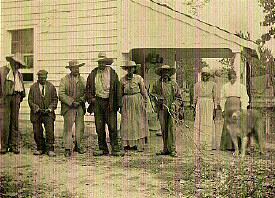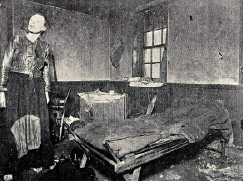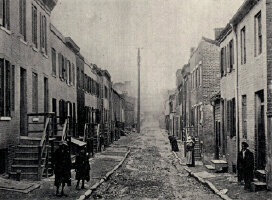The Use and Implications of Photographs for Mental Health Care Reform
- Introduction
- Almshouse Care
- Early Reform Attempts
- Commission Campaign
- Aftermath
- Exhibits October 6, 1908 Report
- Traveling Exhibition images
- Montevue Asylum Images
- Curator's Comments

Maryland State House 1902
Early Reform Attempts
In the early 1890s, a movement initiated by the Lunacy Commisssion and carried forward by the Medical-Chirurgical Faculty, the state medical professional society, promoted improved care for the mentally ill poor. Inspired by New York State's recent passage of a state care act for the insane, the first in the nation, a few Marylanders recognized their state's responsibility for the proper housing and care of the indigent insane. In what could be characterized as a quiet campaign engineered by Dr. George J. Preston, Secretary of the Lunacy Commission, and supported by the medical community, legislation was passed in 1904 whereby the state would take over the care of it indigent insane on January 1, 1909. The State Care Act of 1904 faced no open opposition in the House or Senate with both houses unanimously supporting the passage of the bill. The transfer of mentally impaired county almshouse and asylum residents to state hospitals would be made as soon as practical.
The law was never enacted. Maryland simply lacked the adequate number of spaces within its facilities to house all of its insane poor, and formidable competition for new hospital construction funding existed. The building of good state roads in the interest of economic development was a higher priority for state politicians. In his opening message to the General Assembly in January 1908, Governor Edwin Warfield remarked that "I doubt the feasibility of the State assuming the care and maintenance of all her dependent insane [in 1909], because it will not have adequate buildings and facilities for doing so, and the State Treasury will not be in a condition to bear the burden." The State Care Act was repealed in that year and immediately reinstated, moving the start date two years forward to January 1, 1911. According to some sources, Governor Warfield himself opposed any action on the state care issue during his tenure.

Dr. Arthur P. Herring
Despite the postponement of state care, 1908 was to be a pivotal year for Maryland's indigent mentally impaired. The inauguration of a new, sympathetic governor and the reorganization of the Lunacy Commission heralded a reinvigorated campaign that sought to bring state care before the public eye. Johns Hopkins Hospital's Dr. William E. Welch worked behind that scenes to recruit new members for the commission, replacing four of the five members by August. Welch, as president of the State Board of Health and a health care activist, had Governor Crothers tap Dr. Hugh Young for the position of president. Young, a urologist by training, had assisted in the successful passage of legislation authorizing Maryland's first tuberculosis hospital. Though not trained in psychiatry, Young's humanitarian interest coupled with his influential contacts proved invaluable to the Commission. Commission Secretary, Dr. Arthur P. Herring, served as the key administrator over the daily functions of the body. Herring, a West Virginian by birth, earned his medical degree in 1896 from the Baltimore Medical College, where he then served as a faculty member. Herring acted as the visiting neurologist and psychiatrist at the Bay View Asylum, Baltimore City's almshouse. Herring possessed the medical training and intimate knowledge of the almshouse setting to speak with authority before both politicians and the public. The other three appointed members of the commission included Dr. Henry Hurd, the former superintendent of the Pontiac State Hospital in Michigan, Dr. R. Markley Black, and Dr. John D. Blake. Governor Crothers and Isaac Lobe Straus, Maryland's Attorney General, served as ex officio members.
The reconstituted commission pursued a new, more agressive strategy to appealed directly to the people of Maryland. The members decided to expose the almshouse conditions and launch a campaign to enlist the support of Maryland's medical community and influential citizens throughout the counties. "Public sympathy, both professional and lay, is necessary to force the Legislature to the realization of the fact that they can no longer 'play politics' with such an important matter, but that they must declare themselves one way or another," observed the Maryland Medical Journal. Thirty years of reports describing, sometimes in excruciating detail, the horrific county almshouse and asylum scenes had failed to generate any true political advocacy on behalf of the pauper insane. As the Journal noted: "If the Lunacy Commission and the medical profession are not fully prepared to face this issue with determination to win and with the full assurance that they are supported by the intelligent laity, then the probabilities are that there will be another delay or possibly the bill will be repealed." Rather than continuing to rely on the good graces of politicians, the commission would use the camera in its fight for mental health care reform.

Kent County Almshouse residents, 1908
During the early twentieth century, a movement arose across America broadly designed to ameliorate long-standing social problems. A product of a more scientific approach to philanthropy engendered by post-Civil War reformers, the Progressive Movement, as it came to be known, enlisted specialized studies and formalized surveys to systematically understand the basis of community ills. Areas of particular interest included the housing of the poor, conditions in factories, child labor and mental health care reform. Progressives hoped to draw public attention of their reports, but for the most part they sought to convince state and national politicians to enact legislation as the means to bring about societal change. In essence, they solicited the legal and financial support of government in their crusade for better conditions.


Progressive reformers used documentary photographs in their campaigns for both educational and dramatic effect. The pioneering work of Jacob Riis, a Danish-born columnist for the New York Tribune who sought to expose the poor housing conditions in New York City, is often cited as the model. Riis took his camera into the dank basements and cramped alleyways that characterized the homes of immigrants. With his images made into lantern slides, the journalist revealed his findings through illustrated lectures to church groups and organizations. His work brought the needed public exposure and the eventual and necessary political support that ultimately brought about changes in the laws.
Maryland reformers also employed photographs to publicize their campaigns. The camera had been used extensively and successfully in exposing substandard housing conditions in 1907 Baltimore. The Charity Organization Society and the Association for the Improvement of the Condition of the Poor published a ninety-six page report that uncovered the unsanitary conditions present in the rented dwellings of the city's immigrant and poor populations. Janet E. Kemp compiled surveys of the residents in three Baltimore neighborhood that ringed the harbor. Twenty-nine images of dark alleyways and cellar apartments, often incorporating children, provided emotionally charged evidence that change was needed.
Photographs were also important role in the community health education campaign designed to combat the spread of tuberculosis. The Maryland Tuberculosis Commission, in cooperation with several private groups, sought to heighten public awareness about a disease that was reaching epidemic proportions within the state. At its January 25, 1904, public health exhibition held in McCoy Hall on the Johns Hopkins University campus, the Tuberculosis Commission used images from a northwest Baltimore neighborhood known as the "Lung Block" to illustrate the conditions that led to the transmission of tuberculosis. A series of interiors from local sweatshops and shots of New York tenements were also featured. An allied group in this campaign, the Maryland Association for the Prevention and Relief of Tuberculosis, delivered illustrated lectures using lantern slides.
|
This web site is presented for reference purposes under the doctrine of fair use. When this material is used, in whole or in part, proper citation and credit must be attributed to the Maryland State Archives. PLEASE NOTE: The site may contain material from other sources which may be under copyright. Rights assessment, and full originating source citation, is the responsibility of the user. |
© Copyright December 15, 2023 Maryland State Archives
